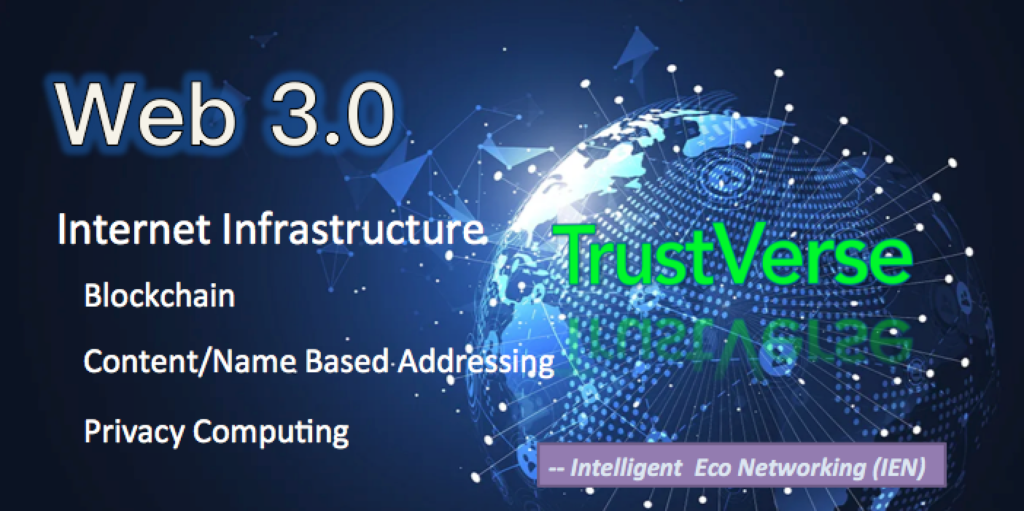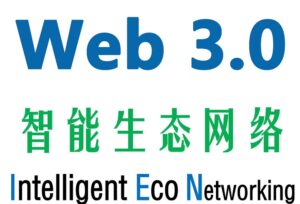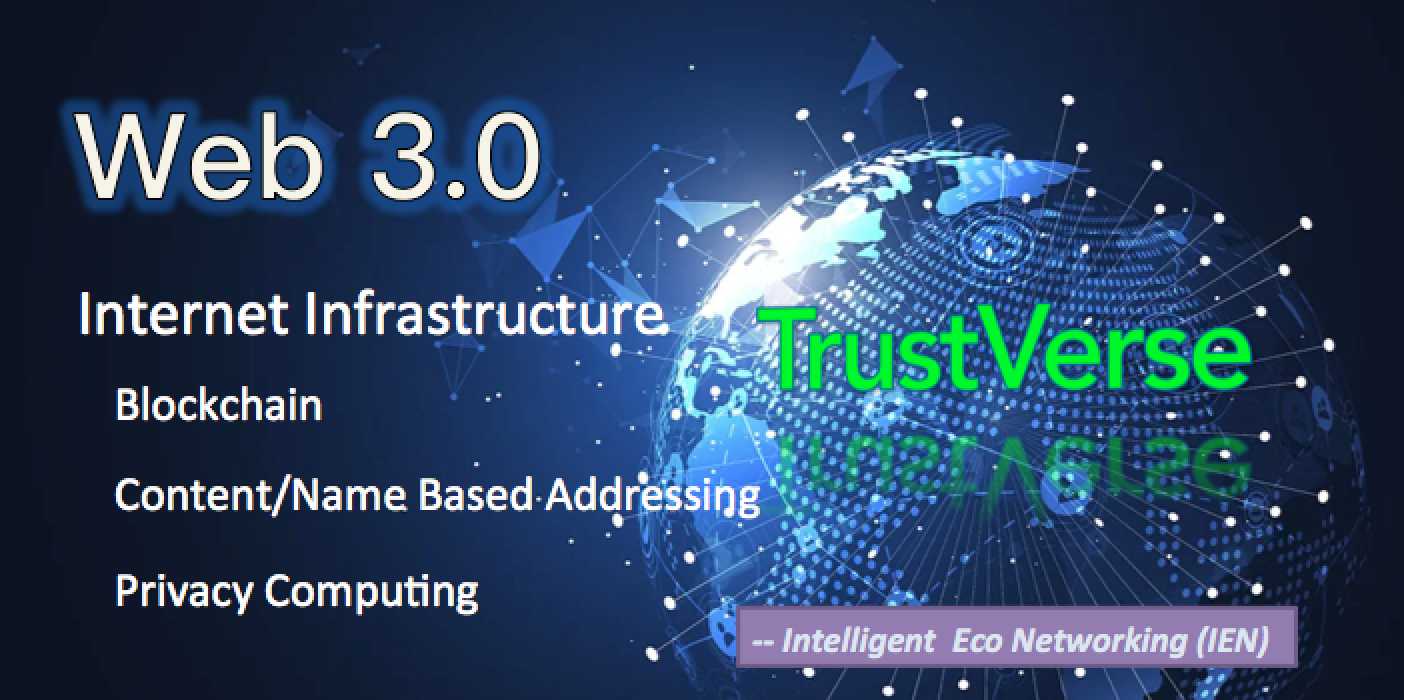What is IEN?
IEN is an abbreviation for “Intelligent Eco Networking“, was first introduced by Prof. Kai Lei from Peking University ICNLAB in 2018 IEEE HotICN.
IEN stands for Named Data Networking + Blockchain + Distributed AI networking Control;

From the name alone, you can tell it is probably a new generation of Internet architecture. “Intelligence” indicates that there should be feedback and adjustment. “Eco” can infer that there should be components interacting with each other. The above is probably all the information we can get from the name, but it is still very vague. In order to have a better understanding, then let me introduce it for you from its background and definition.
For more Information, please read history articles of Intelligent Eco Networking(IEN)

Background
With the increasing computation and communication in the age of Big Data and IoT, traditional network architecture is unable to adapt to today’s social and economy ecosystem. This incompatibility is reflected in all aspects from network physical infrastructure devices to network software applications.
- Traditional network infrastructure devices are bundled with the functionality it provides, which lead to inefficient, costly and inflexible deployment of new network services.
- Address-based packets delivering service provided by TCP/IP is insensitive to content, making it complex and inaccessible to content that users need.
- Traditional network has poor perception of the network environment, which makes it impossible to quickly and intelligently take effective traffic control measures when network environment changes.
- In the era of the Internet of Everything, various IoT devices with different performances are connected to the Internet, which makes the complexity of the network scene far more than the concept of original designers.
The emergence of some technologies has attracted people’s attention. ICN and NDN enable the network to perceive the content more granular; NFV and SDN provide more flexible network traffic control measures; Cloud computing and edge computing offer users elastic computing and storage resources; Blockchain ensures data security with a decentralized consensus framework. Blockchain over ICN can implement a simplier and more straight-forward decentralized system, and the BlockNDN can improve effective use of weak connectivity, reduce broadcasting overhead and increases network efficiency. However, there is still no a network system that can integrate these technologies well.
Motivation
IEN proposes to call for attention of taking the Valuable Knowledge Data (VKD,excluding those excess data,even virus or poison data) and Data Knowledge Technologies into design of Future Internet (In term of “into”, which means to be imported into lower network layers ) . Generally, data with certain meaning can be interpreted as information. In order to build a fair and reciprocal network economy, IEN focuses on the value of the information itself for economic settlement, rather than data flow originally. VKD has three main characteristics:
- VKD can be a variety of different expressions (data from different IoT devices, utilize different encoding methods or compression formats);
- VKD contrusts a value system for recognition and has to achieve trust maintenance;
- VKD can be directly used for transactions. Value maintenance and circulation of the cross value system can be guaranteed since valuable content data itself is a transaction object.
A new network system, especially as for a future Internet, has to handle these problems in need. The goal of IEN is to establish a prosperous mutual-contributed and mutual beneficial knowledge-oriented networking industry ecosystem for future IoT, Vehicle, Robot Networks and beyond.
With all the mentioned, we have a roughly knowledge about the requirement and goal of IEN. And in addition, It will be better to understand with the detailed definition of IEN.
Definition
Intelligent Eco Networking (IEN) aims to gradually evolve to be an advanced infrastructure for future Internet of intelligence which treats valuable knowledge as the first-class entity, motivated by data exchange, manipulated by artificial intelligence, based on the approaches of software defined, virtualized and programmable devices, additionally by comprehensively measuring the cost and gain of storage, computing and network resources, it also integrates decentralized consensus trust preservation and tokenized fine-grained allocation mechanism of blockchain to establish a prosperous mutual-contributed and mutual beneficial value-oriented networking industry ecosystem.
The basic architecture of Intelligent Eco Networking is mainly composed of Network functions configurable device, Multi-layer controller system, Content-Centric network protocol, Trust management and Cloud/Fog/Haze computing group. For IoT, the IEN architecture combines with content center, blockchain and AI. The details of its infrastructures are as follows:

Architecture Concept
A. Network function configurable device
As shown in the figure, the network function configurable device can be the IEN-Hub, the IEN-Router, or IEN-Core Router, depending on its performance. The multi-layer control system can realize different network transmission functions by configuring control processing module (CPM) in the device to achieve different network transmission functions. The traffic collection module (TCM) can periodically collect network environment information (eg. route table, cache queue length) and traffic information (eg, packet size and receiving frequency). This information will be uploaded to the control panel to assist in formulating transmission strategy. The network function configurable device implements a physical abstraction layer that contains multiple customizable physical interfaces (eg, 5G, wifi, Bluetooth). It makes software applications do not need to consider the underlying heterogeneous environment, and simultaneously access to devices with different performances and different communication methods.
It should be noted that the IEN-Hub is loosely managed by the controller because of its too low computing capability to burden heavy tasks, which only serves as a unified access point for various heterogeneous terminals but can be stimulated for sharing valuable content to earn IEN coins, acting like ’’small miners”. And the IEN-Router and IEN-Core Router can not only perform complex network forwarding, but also provide computing and storage for the Cloud/Fog/Haze hierarchical framework, which will be explicated in section E.
B. Multi-layer control system
It intelligently implements transmissions control through configurable device by combining AI Big Data with operator-customized service policies.
As shown in the figure, we will divide the control system into the IEN domain control panel and the IEN Global control panel. The IEN Global control panel sets regulating the overall network and developing different service forwarding strategies for different services. By learning network flow information with cloud computing, it classifies different data streams into different services and provides corresponding service processing methods. The IEN control panel is responsible for the data forwarding path in the local area network. By learning the network environment information with fog computing, it can plan the forwarding path that is most suitable for the data flow.
C. Content-Centric network protocol
The IEN network protocol uses the content name instead of the address as the data packet header of the network protocol stack. By matching the content name in the data packet, the network can find corresponding data which is needed by users. Each packet content name also carries a mandatory data signature, which ensures the network security. The Content-Centric protocol has a network layer caching function. Transmitted content will be cached in each switch that it traverses, to response that requests for the same content come, switches could search their cache to find the corresponding content and achieve a faster response.
D. Distributed Trust management
To ensure the security and stability of the network infrastructure, IEN builds a trust management model to validate data packets. The trust model is based on blockchain technology. The reliability of the trust anchor and the certificates that it issues are guaranteed through distributed consensus. At the same time, the hierarchical structure makes the content name highly expressive and provides a sufficient context for content verification. The trust model supports content based confidentiality. Content producers can encrypt content after producing it and assign corresponding decryption keys to authorized consumers. In this way, the confidentiality of the content does not depend on the intermediate device to ensure authentic end-to-end confidentiality, end-to-end confidentiality.
E. Cloud/Fog/Haze hierarchical framework
The traditional IoT service framework relies entirely on the computing storage capacity provided by the cloud. With the increase of IoT devices, this frame work faces challenges in terms of latency, bandwidth, and device energy consumption. At the same time, more and more network devices still have idle computing and storage resources besides satisfying their own functions.
Therefore, we propose a Cloud/Fog/Haze hierarchical framework for the IoT. The Cloud consists of computer clusters with supercomputing and storage capabilities, providing IoT network with big data analysis and data persistence storage service. The Fog consists of network devices that have better computing and storage performance, such as IEN-Router and IENCore Router. The Fog is closer to users and provides a more low-latency and intelligent services. The Haze, which is the closest part of framework to users, consists of network devices with relatively poor performance such as IEN-Hub.
The Cloud/Fog/Haze hierarchical framework is more sensitive to users behavior than the traditional IoT service framework, providing smarter and lower latency services. Besides, the cloud/ fog/haze frame work effectively improves the resource utilization of network devices. By employing this kind of framework, the centralized management and charging model of resources is transformed into a sharing model, forming a new network model and ecology.
More about Intelligent Eco Networking (IEN) …
